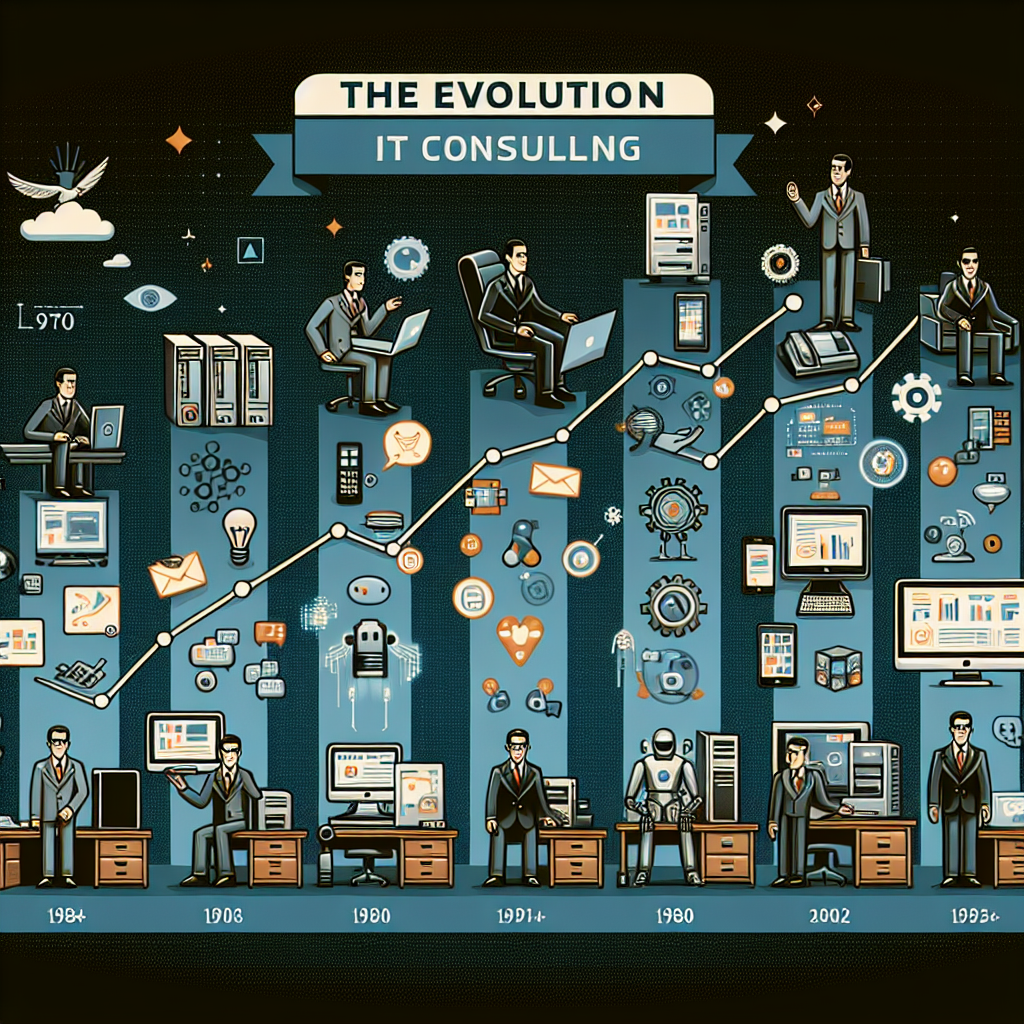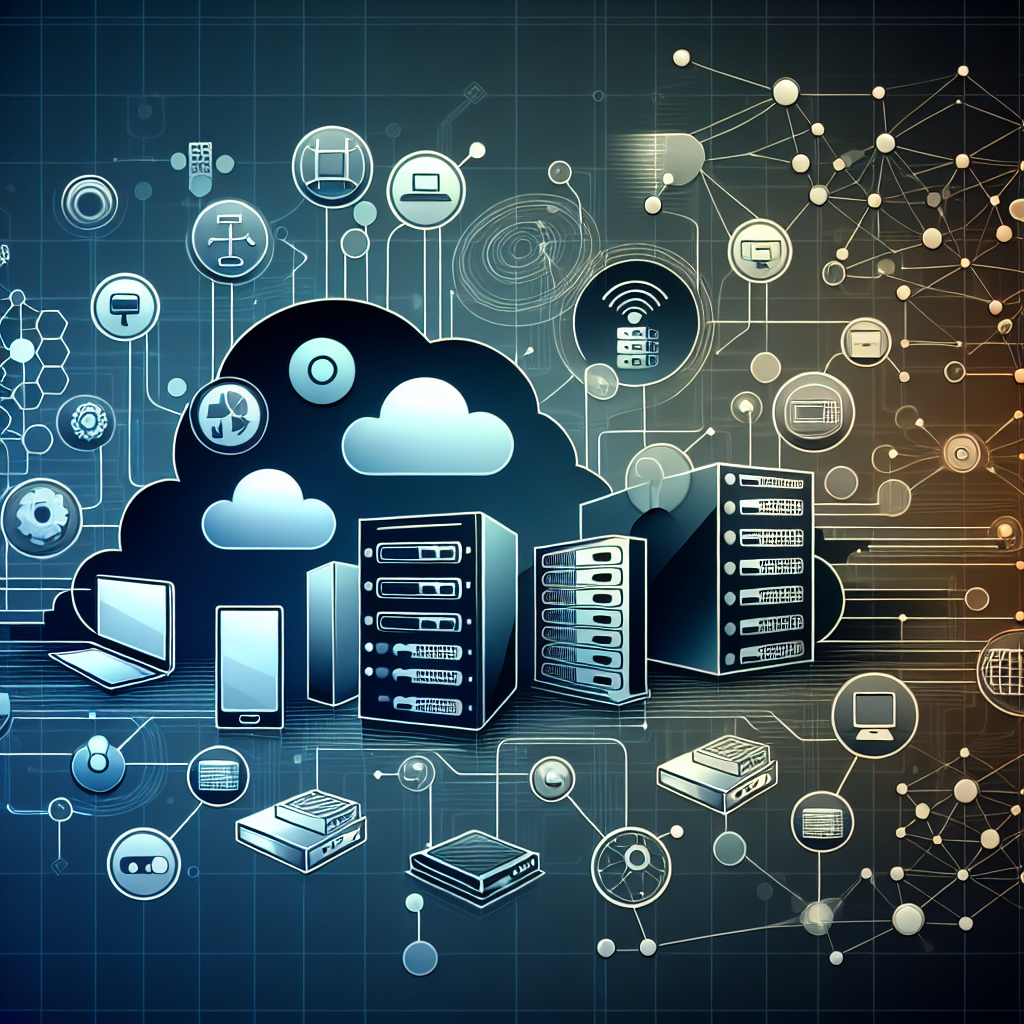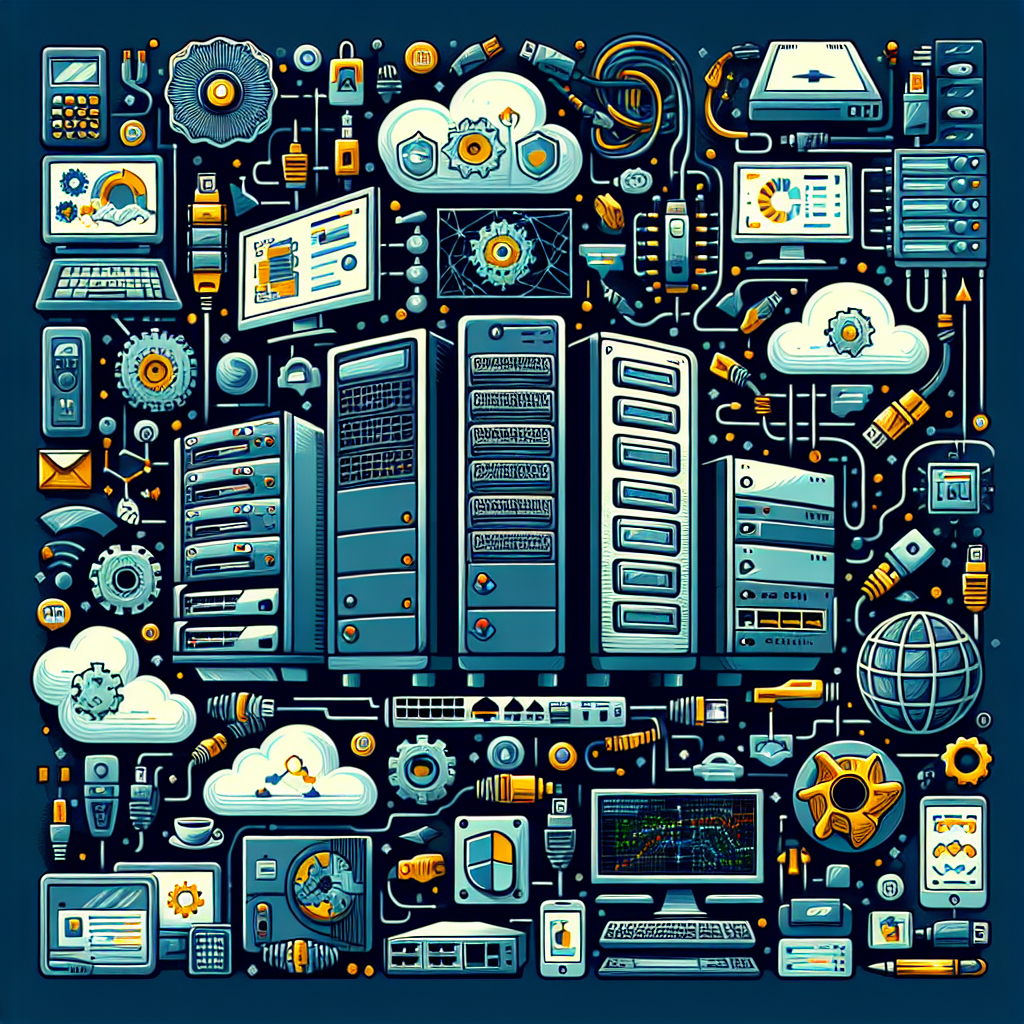Your cart is currently empty!
Tag: Technologies

The Evolution of IT Consulting: Trends and Technologies to Watch
IT consulting has come a long way since its inception, evolving with the ever-changing landscape of technology. As businesses continue to rely on technology to drive growth and innovation, the role of IT consultants has become increasingly crucial in helping organizations navigate the complex world of technology.One of the key trends in IT consulting is the shift towards cloud computing. Cloud computing allows organizations to access and store data and applications over the internet, rather than on physical servers. This not only reduces costs associated with maintaining physical infrastructure but also provides greater flexibility and scalability for businesses. IT consultants are increasingly helping organizations migrate to the cloud, ensuring a smooth transition and optimal performance.
Another trend in IT consulting is the rise of artificial intelligence (AI) and machine learning. These technologies have the potential to revolutionize the way businesses operate, by automating processes, predicting trends, and improving decision-making. IT consultants are helping organizations leverage AI and machine learning to streamline operations, enhance customer experiences, and drive business growth.
Cybersecurity is another area where IT consulting is playing a critical role. With the increasing number of cyber threats and data breaches, organizations are turning to IT consultants to help them bolster their security measures and protect their sensitive information. Consultants are implementing robust security protocols, conducting regular vulnerability assessments, and providing training to employees to ensure they are aware of potential risks.
The Internet of Things (IoT) is also shaping the future of IT consulting. IoT devices are becoming more prevalent in both consumer and business environments, creating new opportunities for organizations to collect and analyze data in real-time. IT consultants are helping businesses integrate IoT devices into their operations, optimize data management, and develop strategies to capitalize on the insights gained from IoT data.
As technology continues to evolve, so too will the role of IT consulting. Organizations will increasingly rely on consultants to help them navigate the complexities of technology, implement cutting-edge solutions, and stay ahead of the competition. By staying abreast of the latest trends and technologies in IT consulting, businesses can position themselves for success in the digital age.

The Future of Managed Service Providers: Trends and Technologies to Watch
Managed service providers (MSPs) play a crucial role in helping businesses navigate the ever-evolving landscape of technology. As technology continues to advance at a rapid pace, MSPs are tasked with staying ahead of the curve and providing cutting-edge solutions to their clients. In this article, we will explore the trends and technologies that are shaping the future of MSPs.One of the key trends that MSPs are currently facing is the shift towards cloud-based services. With more and more businesses moving their operations to the cloud, MSPs are being called upon to provide expertise in managing and securing cloud environments. This includes helping clients migrate their data and applications to the cloud, as well as implementing robust security measures to protect sensitive information.
Another trend that is shaping the future of MSPs is the increasing demand for managed cybersecurity services. With cyber threats becoming more sophisticated and prevalent, businesses are looking to MSPs to provide comprehensive security solutions to protect their networks and data. MSPs are now offering services such as threat detection and response, vulnerability assessments, and security awareness training to help clients defend against cyber attacks.
In addition to cloud and cybersecurity services, MSPs are also embracing technologies such as artificial intelligence (AI) and machine learning to enhance their offerings. AI-powered tools can help MSPs automate routine tasks, improve efficiency, and provide predictive analytics to anticipate and prevent potential issues before they arise. By leveraging these technologies, MSPs can deliver more proactive and personalized services to their clients.
As the role of MSPs continues to evolve, it is essential for them to stay abreast of the latest trends and technologies in the industry. By investing in training and development, staying informed about emerging technologies, and adapting their services to meet the changing needs of their clients, MSPs can position themselves as trusted advisors in a rapidly changing technological landscape.
In conclusion, the future of managed service providers is bright, with opportunities for growth and innovation abound. By embracing cloud services, cybersecurity solutions, and emerging technologies such as AI, MSPs can continue to provide valuable services to their clients and remain at the forefront of the industry. As businesses continue to rely on technology to drive their operations, MSPs will play a crucial role in helping them succeed in the digital age.

The Future of Help Desk: Trends and Technologies to Watch
As technology continues to advance at a rapid pace, the future of help desks is evolving as well. With the rise of artificial intelligence, automation, and other emerging technologies, help desks are becoming more efficient, responsive, and user-friendly than ever before. In this article, we will explore some of the key trends and technologies that are shaping the future of help desks.One of the most significant trends in the world of help desks is the increasing use of artificial intelligence (AI) and machine learning. AI-powered chatbots are now being used to provide instant assistance to customers, answer common questions, and even troubleshoot technical issues. These chatbots can quickly analyze customer inquiries, provide relevant information, and direct users to the appropriate resources for further assistance. This not only helps to improve customer satisfaction but also allows help desk agents to focus on more complex issues that require human intervention.
Another trend that is shaping the future of help desks is the growing focus on self-service options. Many companies are now offering self-service portals and knowledge bases where customers can find answers to their questions and troubleshoot common issues on their own. By providing customers with the tools and resources they need to resolve issues independently, companies can reduce the volume of incoming support requests and improve overall efficiency.
Automation is also playing a key role in the future of help desks. By automating routine tasks such as ticket triaging, routing, and escalation, help desk agents can spend more time focusing on higher-value activities that require human expertise. Automation can also help to streamline workflows, reduce response times, and improve overall service quality.
In addition to AI, self-service options, and automation, other technologies such as augmented reality (AR) and virtual reality (VR) are also starting to make their way into the world of help desks. AR and VR technologies can be used to provide remote assistance, guide customers through troubleshooting processes, and even offer virtual training sessions. These immersive technologies can help to enhance the customer experience, improve problem-solving capabilities, and reduce the need for on-site support visits.
Overall, the future of help desks is bright, with the adoption of AI, automation, self-service options, and other emerging technologies helping to drive innovation and improve customer support. By staying ahead of these trends and embracing new technologies, companies can position themselves for success in the increasingly digital and fast-paced world of customer service.

The Future of Business Continuity: Trends and Technologies to Watch
Business continuity is a critical aspect of any organization’s strategy for ensuring that operations can continue in the face of unexpected disruptions. As technology evolves and new challenges emerge, the future of business continuity is constantly evolving. Here are some key trends and technologies to watch in the coming years.1. Cloud-based solutions: The cloud has revolutionized the way businesses operate, offering increased flexibility, scalability, and cost-effectiveness. Cloud-based business continuity solutions are becoming increasingly popular, allowing organizations to store data and applications off-site and access them in the event of a disaster.
2. Artificial intelligence and machine learning: AI and machine learning technologies are being used to enhance business continuity planning and response. These technologies can analyze vast amounts of data to predict potential disruptions and automate response processes, helping organizations to minimize downtime and recover more quickly.
3. Internet of Things (IoT): The IoT is connecting devices and sensors to the internet, providing real-time data on everything from equipment performance to environmental conditions. This data can be used to improve business continuity planning by identifying vulnerabilities and predicting potential disruptions before they occur.
4. Cybersecurity: Cyber attacks are a major threat to business continuity, with hackers constantly seeking to disrupt operations and steal sensitive data. As cyber threats evolve, organizations must invest in robust cybersecurity measures to protect their systems and data.
5. Remote work solutions: The COVID-19 pandemic has accelerated the shift towards remote work, highlighting the importance of ensuring that employees can work effectively from anywhere. Business continuity plans must now include provisions for remote work, including secure access to company systems and data.
6. Blockchain technology: Blockchain technology offers a secure and transparent way to store and share data, making it ideal for ensuring the integrity of critical information during a disruption. By leveraging blockchain technology, organizations can enhance the security and resilience of their business continuity plans.
7. Data analytics: Data analytics can provide valuable insights into business operations, helping organizations to identify trends and patterns that may impact continuity. By analyzing data from various sources, organizations can make more informed decisions and proactively address potential disruptions.
In conclusion, the future of business continuity is evolving rapidly, driven by advancements in technology and changes in the business landscape. By staying abreast of these trends and technologies, organizations can better prepare for and respond to disruptions, ensuring that their operations remain resilient and sustainable in the face of uncertainty.

Top Tools and Technologies for Managing IT Infrastructure
In today’s fast-paced and technology-driven world, managing IT infrastructure is crucial for businesses to stay competitive and efficient. With the increasing complexity and scale of IT systems, it’s important to have the right tools and technologies in place to effectively manage and monitor infrastructure.Here are some of the top tools and technologies for managing IT infrastructure:
1. Infrastructure Monitoring Tools: These tools provide real-time monitoring of network, server, and application performance to identify issues and bottlenecks before they impact users. Popular monitoring tools include Nagios, Zabbix, and SolarWinds.
2. Configuration Management Tools: These tools automate the process of configuring and managing servers, ensuring consistency and reducing the risk of human error. Tools like Puppet, Chef, and Ansible help streamline infrastructure management tasks.
3. Virtualization Technologies: Virtualization allows IT teams to create virtual instances of servers, storage, and networks, enabling greater flexibility and scalability. Leading virtualization technologies include VMware, Microsoft Hyper-V, and Citrix XenServer.
4. Cloud Management Platforms: With the increasing adoption of cloud services, cloud management platforms like AWS CloudFormation, Microsoft Azure Resource Manager, and Google Cloud Deployment Manager help organizations manage and automate their cloud infrastructure.
5. Containerization Tools: Containers provide a lightweight and portable way to package and deploy applications, making it easier to manage complex IT environments. Docker, Kubernetes, and OpenShift are popular containerization tools used for managing IT infrastructure.
6. Network Management Tools: Network management tools help IT teams monitor and troubleshoot network performance, security, and compliance. Tools like Cisco Prime Infrastructure, SolarWinds Network Performance Monitor, and ManageEngine OpManager are widely used for network management.
7. Database Management Tools: Managing databases is a critical aspect of IT infrastructure management. Tools like Oracle Enterprise Manager, Microsoft SQL Server Management Studio, and MySQL Workbench help IT teams monitor and optimize database performance.
8. Incident Management Tools: Incident management tools help IT teams track and resolve incidents and outages quickly and efficiently. Tools like ServiceNow, Jira Service Desk, and Zendesk provide a centralized platform for managing IT incidents.
9. Backup and Disaster Recovery Solutions: Data backup and disaster recovery are essential for protecting critical business data and ensuring business continuity. Popular backup and disaster recovery solutions include Veeam Backup & Replication, Commvault, and Acronis Backup.
10. IT Service Management (ITSM) Platforms: ITSM platforms help organizations streamline and automate IT service delivery and support processes. Leading ITSM platforms like ServiceNow, BMC Helix, and Freshservice help organizations manage IT infrastructure efficiently.
In conclusion, having the right tools and technologies for managing IT infrastructure is essential for ensuring the reliability, performance, and security of IT systems. By leveraging these top tools and technologies, businesses can effectively monitor, automate, and optimize their IT infrastructure to support their digital transformation initiatives.

The Future of Cloud Computing: Emerging Technologies and Innovations
Cloud computing has been a game-changer in the world of technology, enabling businesses to store, manage, and access data and applications over the internet rather than on physical servers. As technology continues to advance at a rapid pace, the future of cloud computing is poised to bring even more innovations and capabilities to the table.One of the emerging technologies that is set to revolutionize cloud computing is edge computing. Edge computing brings processing power closer to the devices that are generating data, reducing latency and increasing efficiency. This technology will allow for faster and more real-time data processing, making it ideal for applications such as autonomous vehicles, smart cities, and IoT devices.
Another exciting development in cloud computing is the rise of serverless computing. Serverless computing allows developers to run code without having to manage servers, allowing them to focus on writing and deploying code rather than worrying about infrastructure. This technology offers a more efficient and cost-effective way to run applications, as users only pay for the resources they use.
Artificial intelligence and machine learning are also set to play a significant role in the future of cloud computing. These technologies can analyze vast amounts of data to provide insights and predictions, enabling businesses to make more informed decisions. Cloud providers are increasingly integrating AI and machine learning capabilities into their platforms, making it easier for users to leverage these technologies.
Security is always a top concern when it comes to cloud computing, and new innovations are being developed to address these concerns. One such innovation is confidential computing, which allows data to be processed in a secure enclave, protecting it from unauthorized access. This technology ensures that sensitive information remains confidential, even when it is being processed in the cloud.
With these emerging technologies and innovations, the future of cloud computing is looking brighter than ever. Businesses will be able to take advantage of faster processing speeds, more efficient resource management, and enhanced security measures to drive innovation and growth. As technology continues to evolve, the possibilities for cloud computing are endless, and the potential for businesses to leverage these advancements is limitless.

The Evolution of Cybersecurity: Adapting to New Technologies and Risks
In today’s digital age, cybersecurity has become more important than ever before. With the rise of new technologies and the increasing interconnectedness of the world, the need to protect sensitive information and data from cyber threats has never been more urgent.The evolution of cybersecurity can be traced back to the early days of computing, when basic antivirus programs were used to protect against simple viruses and malware. As technology advanced, so did the sophistication of cyber threats, leading to the development of more advanced security measures such as firewalls, encryption, and intrusion detection systems.
However, with the rapid pace of technological advancements, cybersecurity has had to continually adapt to new risks and challenges. The widespread adoption of cloud computing, mobile devices, and the Internet of Things (IoT) has created new vulnerabilities that cybercriminals can exploit.
One of the biggest challenges facing cybersecurity today is the increasing sophistication of cyber attacks. Hackers are constantly developing new techniques to breach security systems and steal valuable data. From phishing scams and ransomware attacks to sophisticated hacking techniques like zero-day exploits, cybersecurity professionals must stay one step ahead to protect against these evolving threats.
In response to these challenges, cybersecurity professionals are increasingly turning to advanced technologies such as artificial intelligence and machine learning to enhance their defenses. These technologies can help identify and respond to threats more quickly and effectively than traditional methods, allowing organizations to better protect their data and systems.
Another key trend in cybersecurity is the shift towards a more proactive approach to security. Instead of simply reacting to threats as they arise, organizations are now taking a more proactive stance by implementing continuous monitoring, threat intelligence, and incident response plans to identify and mitigate risks before they can cause damage.
Ultimately, the evolution of cybersecurity is a constant battle between cybercriminals seeking to exploit vulnerabilities and security professionals working to protect against these threats. By staying informed about the latest technologies and risks, organizations can better adapt their cybersecurity strategies to meet the challenges of today’s digital landscape. Only by continually evolving and adapting to new technologies and risks can we hope to stay one step ahead of cyber threats and protect our sensitive information in an increasingly connected world.

Top Tools and Technologies for Streamlining Network Management
In today’s digital age, network management is more important than ever for businesses to ensure seamless connectivity and smooth operations. With the increasing complexity of networks and the ever-growing demand for faster and more reliable connections, it has become essential for organizations to leverage top tools and technologies to streamline their network management processes.Here are some of the top tools and technologies that are revolutionizing network management:
1. Network Monitoring Tools: Network monitoring tools are essential for keeping track of the performance and health of your network infrastructure. These tools provide real-time insights into network traffic, bandwidth usage, and device performance, allowing IT teams to quickly identify and address any issues that may arise.
2. Network Configuration Management Tools: Network configuration management tools help IT teams streamline the process of configuring and managing network devices. These tools automate the configuration process, reducing the risk of human error and ensuring consistency across the network.
3. Software-Defined Networking (SDN): SDN is a revolutionary technology that allows organizations to centrally manage and control their network infrastructure through software. SDN enables greater flexibility, scalability, and automation, making it easier to adapt to changing business needs and optimize network performance.
4. Network Automation Tools: Network automation tools automate manual network management tasks, such as device provisioning, configuration changes, and troubleshooting. By automating repetitive tasks, IT teams can save time and resources, allowing them to focus on more strategic initiatives.
5. Artificial Intelligence (AI) and Machine Learning: AI and machine learning are transforming network management by providing predictive analytics and insights into network performance. These technologies can identify patterns and anomalies in network data, enabling IT teams to proactively address issues before they impact operations.
6. Cloud-Based Network Management Platforms: Cloud-based network management platforms provide a centralized solution for managing and monitoring network infrastructure across multiple locations. These platforms offer scalability, flexibility, and accessibility, allowing organizations to easily manage their networks from anywhere, at any time.
7. Network Security Tools: Network security is a top priority for organizations, and network security tools help protect against cyber threats and vulnerabilities. These tools include firewalls, intrusion detection systems, and encryption technologies to safeguard sensitive data and prevent unauthorized access.
By leveraging these top tools and technologies, organizations can streamline their network management processes, improve efficiency, and enhance overall network performance. With the increasing complexity of networks and the growing demand for faster, more reliable connections, investing in these tools is essential for staying ahead in today’s competitive business landscape.

How Network Management is Evolving with the Rise of IoT and Cloud Technologies
Network management is undergoing a significant transformation with the rise of Internet of Things (IoT) and cloud technologies. As more devices become connected and the demand for data processing and storage increases, traditional network management methods are no longer sufficient to meet the needs of today’s digital landscape.The IoT is revolutionizing the way devices communicate with each other and with the cloud. This interconnected network of devices, sensors, and machines generates massive amounts of data that need to be processed and analyzed in real-time. As a result, network management tools are now required to handle the increased traffic and ensure that data is transmitted securely and efficiently.
Cloud technologies are also playing a key role in the evolution of network management. The cloud allows organizations to store and access data from anywhere, at any time, making it easier to scale networks and support remote workforces. With the growing adoption of cloud services, network managers are faced with the challenge of ensuring that their networks are able to support the increased data traffic and bandwidth requirements.
In response to these challenges, network management solutions are evolving to incorporate advanced technologies such as artificial intelligence (AI) and machine learning. These technologies enable network managers to automate routine tasks, detect and mitigate security threats, and optimize network performance. By leveraging AI and machine learning, network managers can proactively identify issues before they impact the network, improving overall reliability and performance.
Furthermore, the shift towards software-defined networking (SDN) and network function virtualization (NFV) is also transforming network management practices. SDN allows network managers to centrally manage and configure network resources through software, while NFV enables the virtualization of network functions such as firewalls, routers, and load balancers. These technologies provide greater flexibility and scalability, allowing organizations to adapt to changing network requirements more easily.
Overall, the evolution of network management with the rise of IoT and cloud technologies is enabling organizations to build more efficient, secure, and resilient networks. By embracing advanced technologies and modernizing their network management practices, organizations can better support the growing demands of the digital era and ensure that their networks remain agile and responsive to future challenges.

Top Tools and Technologies for Efficient Network Management
In today’s digital age, network management is crucial for businesses to ensure a smooth and efficient operation of their IT infrastructure. With the increasing complexity of networks, it is essential for organizations to have the right tools and technologies in place to effectively manage their networks.Here are some of the top tools and technologies that can help businesses achieve efficient network management:
1. Network monitoring tools: Network monitoring tools help organizations track the performance and availability of their network infrastructure in real-time. These tools provide insights into network traffic, bandwidth usage, and device performance, allowing IT teams to quickly identify and address any issues that may arise.
2. Network configuration management tools: Network configuration management tools help organizations automate the process of configuring and managing network devices such as routers, switches, and firewalls. These tools help streamline network configuration tasks, reduce errors, and ensure consistency across the network.
3. Network performance management tools: Network performance management tools help organizations optimize the performance of their network infrastructure by monitoring key performance indicators such as latency, packet loss, and throughput. These tools help IT teams identify performance bottlenecks and optimize network resources to improve overall network performance.
4. Network security tools: Network security tools help organizations protect their network infrastructure from cyber threats and attacks. These tools include firewalls, intrusion detection systems, and antivirus software, which help prevent unauthorized access, malware infections, and data breaches.
5. Software-defined networking (SDN): SDN is a technology that allows organizations to centrally manage and control their network infrastructure through software-based controllers. SDN enables organizations to automate network configuration, optimize traffic routing, and improve network scalability and flexibility.
6. Network automation tools: Network automation tools help organizations automate repetitive network management tasks, such as configuration changes, software updates, and network provisioning. By automating these tasks, organizations can reduce manual errors, improve efficiency, and free up IT resources for more strategic initiatives.
7. Cloud-based network management platforms: Cloud-based network management platforms offer organizations a centralized and scalable solution for managing their network infrastructure. These platforms provide visibility and control over the entire network, regardless of its size or complexity, and enable organizations to manage their networks from anywhere, at any time.
In conclusion, efficient network management is essential for businesses to ensure the reliability, performance, and security of their IT infrastructure. By leveraging the right tools and technologies, organizations can streamline network management tasks, improve operational efficiency, and better meet the demands of today’s digital business environment.
